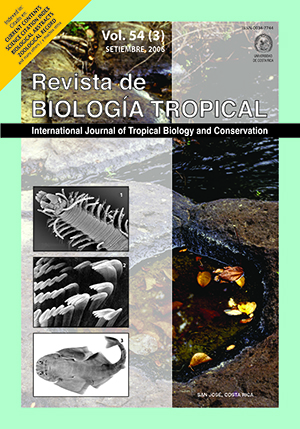Abstract
We evaluated seasonal species presence and richness, and abundance of medium and large sized mammalian terrestrial fauna in the “Mário Viana” Municipal Biological Reserve, Nova Xavantina, Mato Grosso, Brazil. During 2001, two monthly visits were made to an established transect, 2 820 m in length. Records of 22 mammal species were obtained and individual footprint sequences quantified for seasonal calculation of species richness and relative abundance index (x footprints/km traveled). All 22 species occurred during the rainy season, but only 18 during the dry season. Pseudalopex vetulus (Lund, 1842) (hoary fox), Eira barbara (Linnaeus, 1758) (tayra), Puma concolor (Linnaeus, 1771) (cougar) and Hydrochaeris hydrochaeris (Linnaeus, 1766) (capybara) were only registered during the rainy season. The species diversity estimated using the Jackknife procedure in the dry season (19.83, CI= 2.73) was smaller than in the rainy season (25.67, CI= 3.43). Among the 18 species common in the two seasons, only four presented significantly different abundance indexes: Dasypus novemcinctus Linnaeus, 1758 (nine-banded armadillo), Euphractus sexcinctus (Linnaeus, 1758) (six-banded armadillo), Dasyprocta azarae Lichtenstein, 1823 (Azara’s Agouti) and Tapirus terrestris (Linnaeus, 1758) (tapir). On the other hand, Priodontes maximus (Kerr, 1792) (giant armadillo) and Leopardus pardalis (Linnaeus, 1758) (ocelot) had identical abundance index over the two seasons. Distribution of species abundance in the sampled area followed the expected pattern for communities in equilibrium, especially in the rainy season, suggesting that the environment still maintains good characteristics for mammal conservation. The present study shows that the reserve, although only 470 ha in size, plays an important role for conservation of mastofauna of the area as a refuge in an environment full of anthropic influence (mainly cattle breeding in exotic pasture).
##plugins.facebook.comentarios##

This work is licensed under a Creative Commons Attribution 4.0 International License.
Copyright (c) 2006 Revista de Biología Tropical


